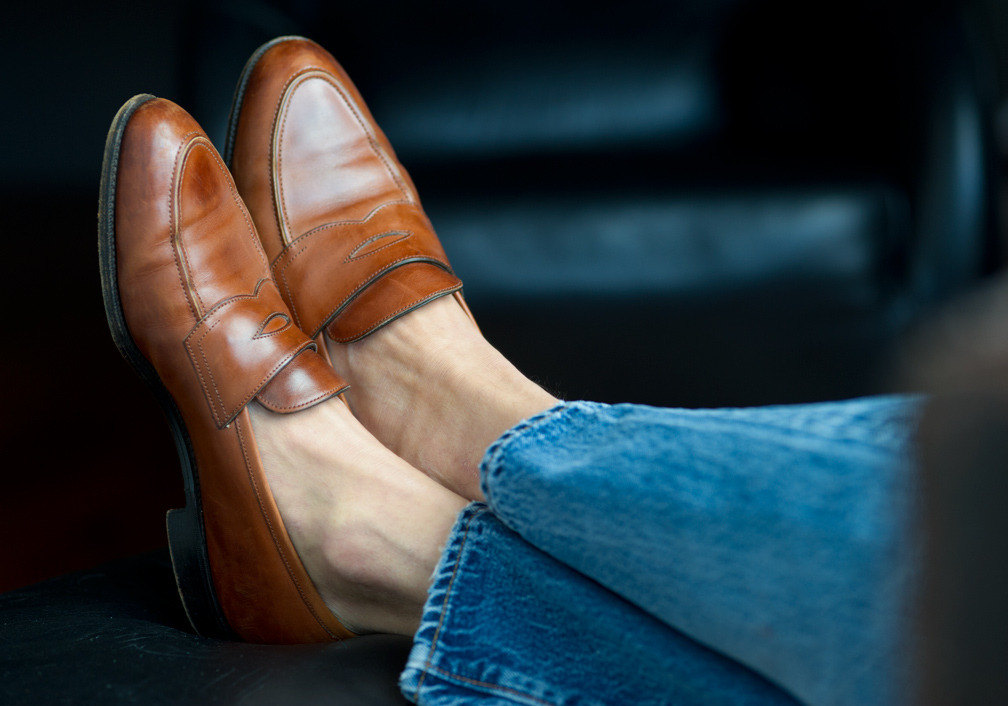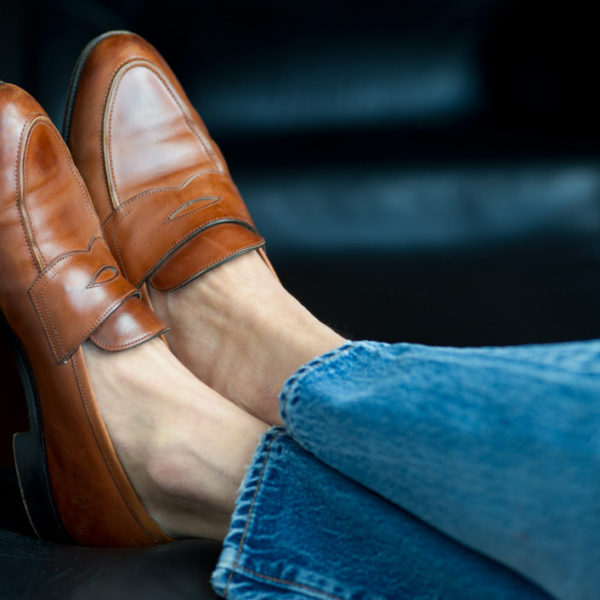
Once the weather warms up and the days get long, I often find that the best shoes are either sneakers or slip-ons. I typically wear sneakers with jeans and casual outerwear, and slip-ons with dressier trousers and sport coats. Styles can really range, but most of the time, sneakers tend to be white and minimalistic, and the slip-ons tend to be penny loafers.
The penny loafer is often thought of as a quintessentially American shoe – a style that’s most at home with tweed jackets and Shetland sweaters, as they were originally worn on Ivy League campuses in the mid-20th century. Today, however, you can safely wear them without any preppy connotations (although, you can also wear them as such, if you wish). With a sleeker pair of European pennies, for example, you can combine them with a soft-shouldered sport coat, wool trousers, and an open collared shirt for a very dégagé Continental look. With some beefroll loafers, jeans, and a light jacket, you can go back to looking like an American, but in a way that doesn’t feel too preppy.
If you haven’t yet got yourself a pair, consider some of these:
- Highly expensive at $750+: JM Weston’s 180 moccasin and John Lobb’s Lopez are pretty iconic, with the first having uniquely high walls around the toe that help distinguish it from the pack. My favorite loafers in this price tier, however, are all from Edward Green – an English firm known for its tasteful designs, quality construction, and beautiful finishing. Check out the Piccadilly, Montpellier, Sandown, and Harrow to start.
- Pricey options between $350 and $500: Less expensive, but no less well-made, are loafers from all of your usual suspects. Carmina, for example, has something that looks very much like Edward Green’s Montpellier, while Alden has a wide range of handsome American designs. More recently, Wildsmith (a bespoke shoemaker once famous for their unlined loafers) relaunched as a ready-to-wear brand, and although their loafers aren’t as close to their originals as Edward Green’s Harrow, they’re priced competitively. Shipton & Heneage will also have a nice range of options, and they’re made a bit more affordable through the company’s Discount Club. Additionally, Crockett & Jones is very much worth a look, as are Alfred Sargent, Sid Mashburn’s house line, Kent Wang’s antique calf loafers, and the newly launched Paul Evans.
- A bit more affordable at $350 and below: Of course, for more affordable shoes, there’s always Allen Edmonds’ factory second store, where the company heavily discounts shoes that didn’t pass quality control. Flaws are often very, very minor, if even visible at all. Loake’s 1880 line is also worth a look, and they sometimes produce for Charles Tyrwhitt and Herring (just note that some Loake-made shoes aren’t of terribly good quality, so use good judgment). Similarly, Ralph Lauren and Brooks Brothers will have some nice models, even though their quality can really range. Stick to the stuff that retails for $350 and above, and wait for end-of-season sales. In addition, Meermin offers some of the best price-to-value ratio right now in footwear, especially once you take into consideration their made-to-order program, and Jack Erwin is the best I’ve seen in the sub-$200 price range. For more American styled loafers, check out Rancourt and Bass’ Made in Maine collection.
- Shell cordovan: Lastly, shell cordovan loafers are worth highlighting. Although shell cordovan is traditionally a workboot material, it works wonderfully today for slightly dressier styles (think wingtips, tassel loafers, and penny loafers). Alden’s Leisure Handsewn is a really beautiful American model, while Carmina will be more European. Meermin may also be able to make you something through their made-to-order program.
(Pictured above: Hooman Majd in his fifteen year old Edward Greens)








